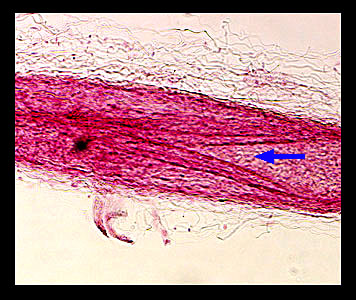|
|
||||||||||||||||||||
|
This is an image of a longitudinal section of a lymphatic vessel (capillary). Note the thin wall as well as the one-way valve within the vessel, which prevents the backflow of lymph. The blue arrow shows the direction of lymph flow. The major mechanism for the exchange of nutrients and wastes across the walls of capillaries is by simple diffusion. In addition to diffusion of substances across the walls of capillaries, bulk flow of essentially protein-free fluid is occurring as well. It is called bulk flow because water and all the low molecular weight solutes dissolved in it move together. The terms filtration and reabsorption describe the direction of the bulk flow. Filtration occurs when the direction of flow is such that protein-free plasma moves from the lumen of the capillary to the interstitial spaces. Reabsorption occurs when the direction of flow is from the interstitial fluid compartment back into the vascular compartment. Over the course of a day, approximately 2-3 more liters of fluid are filtered across the systemic capillaries than are reabsorbed. If this extra cellular fluid were to remain in the interstitial fluid compartment, edema (swelling) would result. In addition, the plasma volume would become depleted. It is the job of the lymphatic capillaries to take up this excess filtered fluid and return it to the vascular compartment (the bloodstream). Once this fluid enters the lymphatic capillaries it is called lymph. |
|
